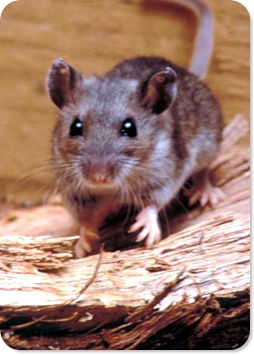 Deer mice - dangerous animals? Believe it!(Published in the Winnipeg Free Press, May 20, 2001) Name some dangerous wildlife. OK, I hear you saying: bears. . . wolves . . . cougars. How about mice, specifically, the deer mouse (Peromyscus maniculatus)? No, they don't attack in ravenous hoards. It's what they can leave behind that's dangerous: Sin Nombre virus (SNV), a form of hantavirus. (The term hantavirus, though it has become synonymous with the disease, is the general term for a specific group of viruses.) With the May long weekend upon us, people's thoughts turn to outdoor activities like gardening, garage cleaning or opening up the cottage, and SNV is something to be aware of. Hantavirus Pulmonary Syndrome (HPS), the disease caused by SNV, is serious stuff, with about a 40% mortality rate, but it is also very rare for people to catch it. You're about as likely to be struck by lightning. Still, it's important to know about it and how to deal with the potential threat. You wouldn't go golfing in a thunderstorm, would you? North Americans were introduced to the SNV variety of hantavirus in 1993, when it was identified as the cause of a disease outbreak, later defined as HPS, in the US southwest. The previously unknown virus is carried exclusively by deer mice. It is merely a parasite to them, causing no harm. It's only when it jumps to humans that it is pathogenic. That's the case with many disease causing microorganisms; they aren't out to make us sick, they're just trying to make a living. When we inadvertently become their hosts, the combination of damage they cause within our unfamiliar bodies and an aggressive response by our own immune systems causes disease. HPS is not a new disease; merely an ancient one finally documented by modern medicine. Re- examination of prior deaths from unexplained pulmonary diseases revealed cases of HPS back to 1959. The traditional medicine of the Navajo people recognizes the disease and even its association with rodents. Since 1993 more than 300 cases of HPS have been documented in North America, mostly in western states and provinces. There have been 2 fatalities in Manitoba in the last couple of years. People get the disease by coming into contact with SNV left behind in fresh mouse pee or poop -- the virus can't survive outside a mouse for more than 48 hr -- or by direct handling of a deer mouse. Most often the virus is inhaled when people disturb places where mice have left their business. Cleaning results in the greatest exposure to SNV, as wiping, brushing or sweeping are all activities that tend to send particles into the air. Deer mice are common in Manitoba, wherever there are woodlands, including cities. Protecting yourself from SNV involves mouse-proofing buildings and knowing how to safely clean contaminated sites. Any holes or cracks more than 6 mm (1/4 inch) can be access points for deer mice. They climb like monkeys, so don't neglect access points up high. And keep a tidy house and cottage, improperly stored food attracts mice. If you suspect an area has been contaminated (if you see mouse poops, which look like small, black rice grains or signs of things being chewed on) then here's what to do. Wet the area with a disinfectant spray, a mixture of 10% household bleach works well, and let it soak for 10 minutes. Then use disposable cloths or paper towels to gently wipe the area clean. Dispose of these in a sealed container or a heavy plastic bag, not just in with the regular garbage. The American Centre for Disease Control web site is the place to look for more information on SNV and HPS. Viruses are the simplest life forms on our plant, often no more than a piece of genetic material in a protein coat. They require the cellular mechanism of other organisms to live and to replicate their own kind. In humans they cause a variety of diseases, from the common cold to HPS and AIDS. And they change themselves rapidly, constantly mutating into new forms to evade the immune systems of their hosts. Did you know that some palaeontologists think that newly mutated viruses may have killed off the dinosaurs? Perhaps the "end of the world" is mutating into a new strain right now, somewhere out there, in some distant rain forest, or under a cottage near you! Thanks for reading! Got to the: < Previous Column | What's Outdoors Front Page | Next Column >
|
||
| You can help NatureNorth produce more great articles with a secure donation through PayPal. Our Google Adsense ads pay our server costs, but that's about it. To learn more follow this link: Support NatureNorth. Thank-you! | |
Return to the: NatureNorth.com Front Page
Or pick a seasonal issue to visit:
